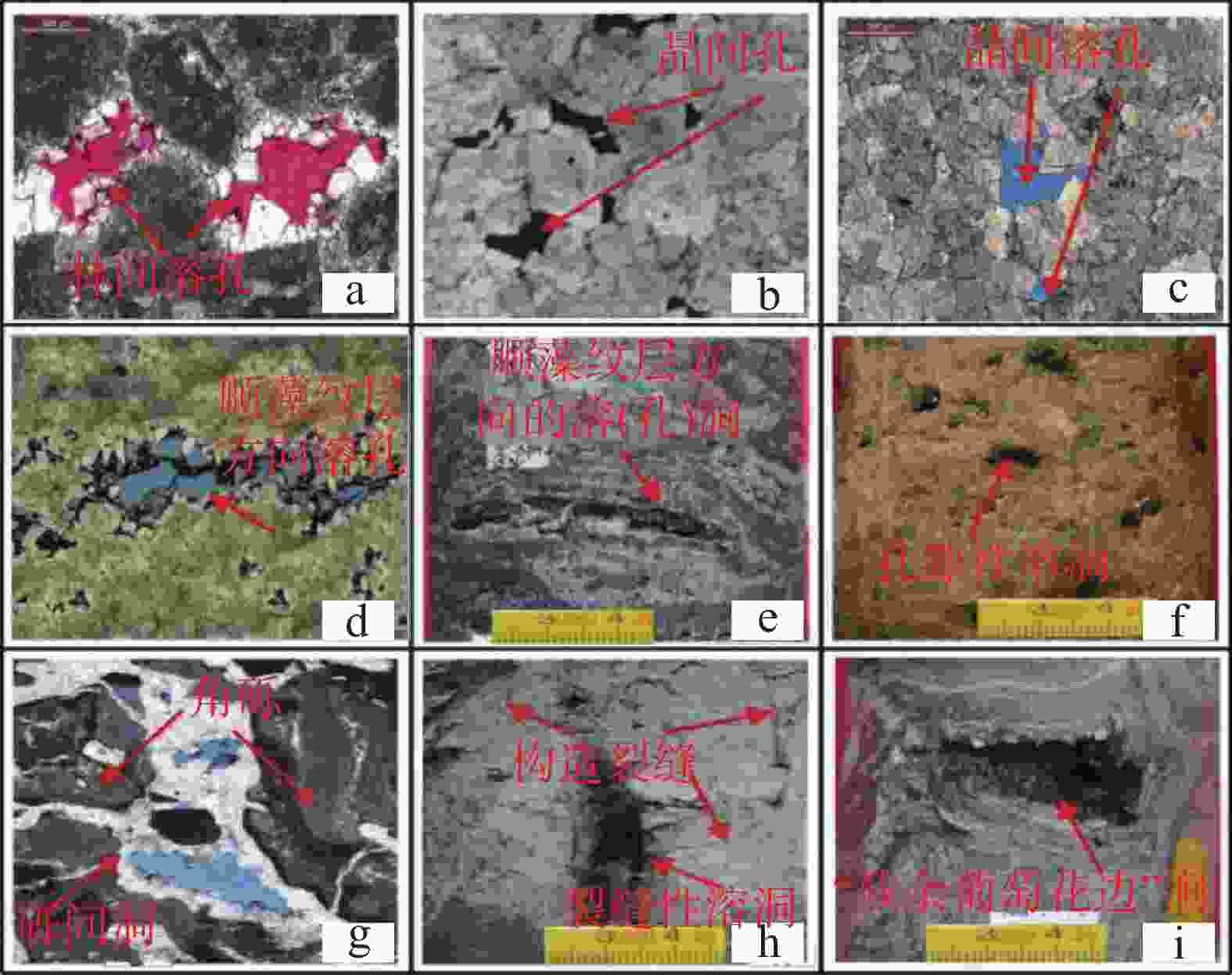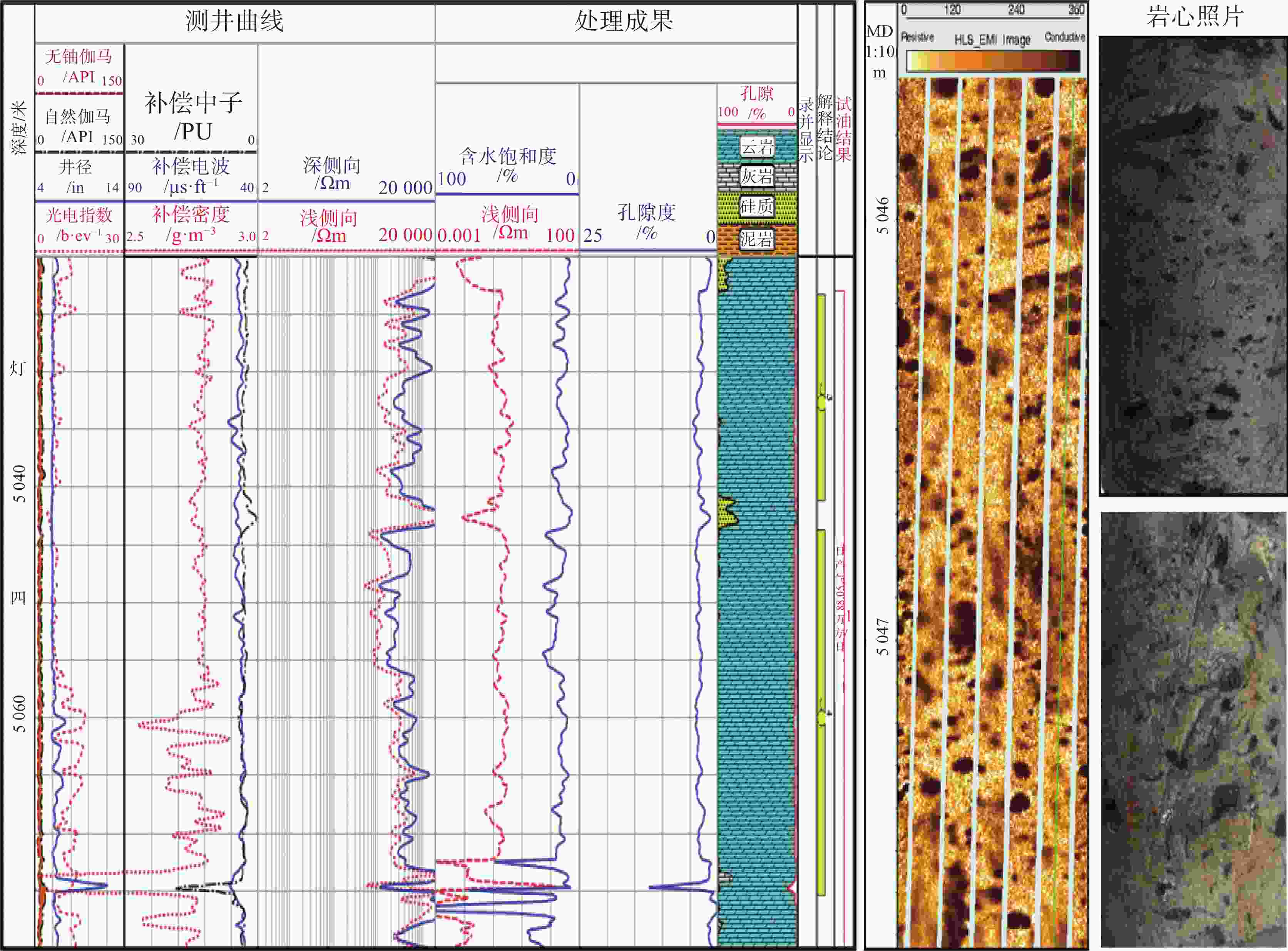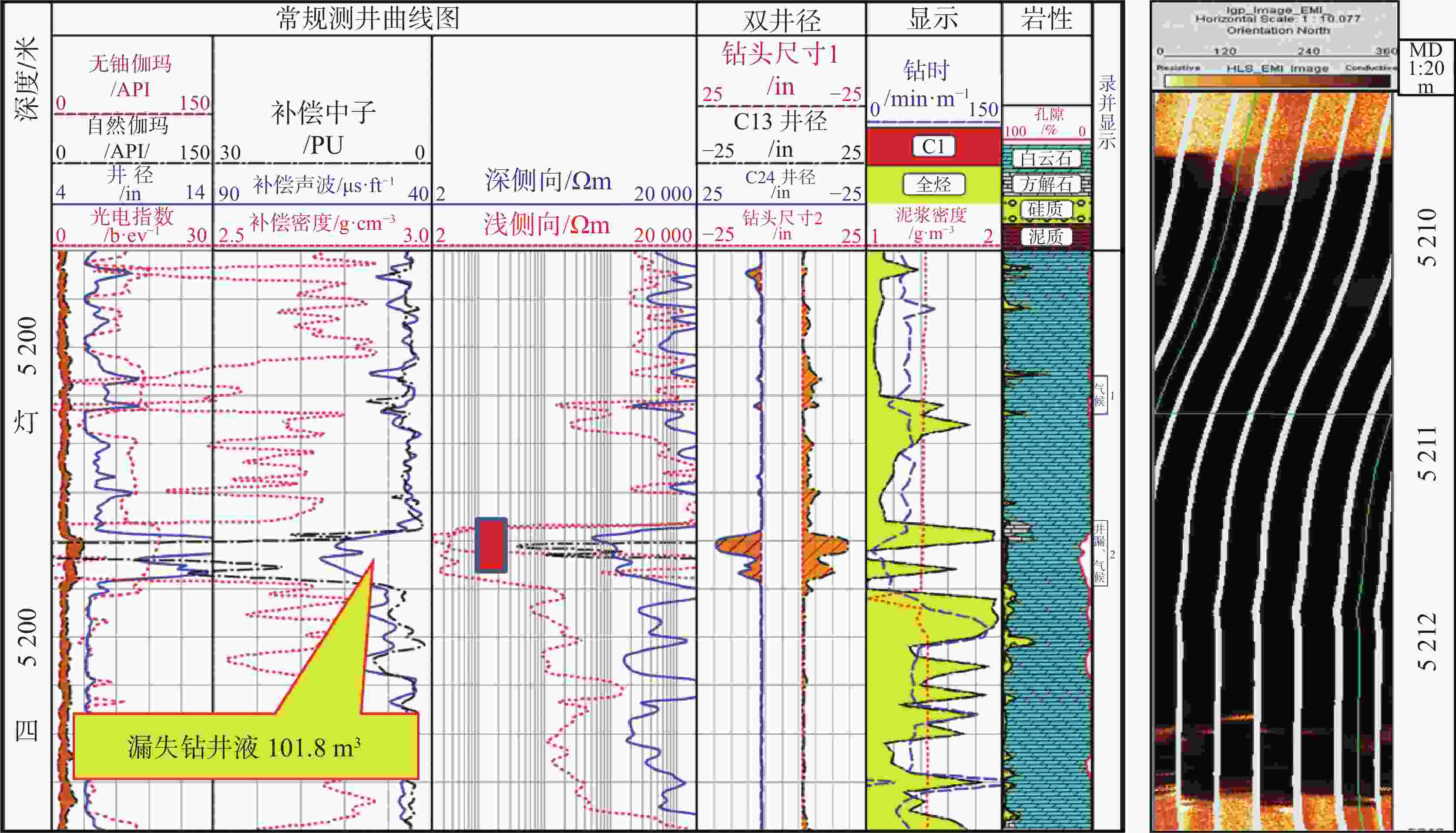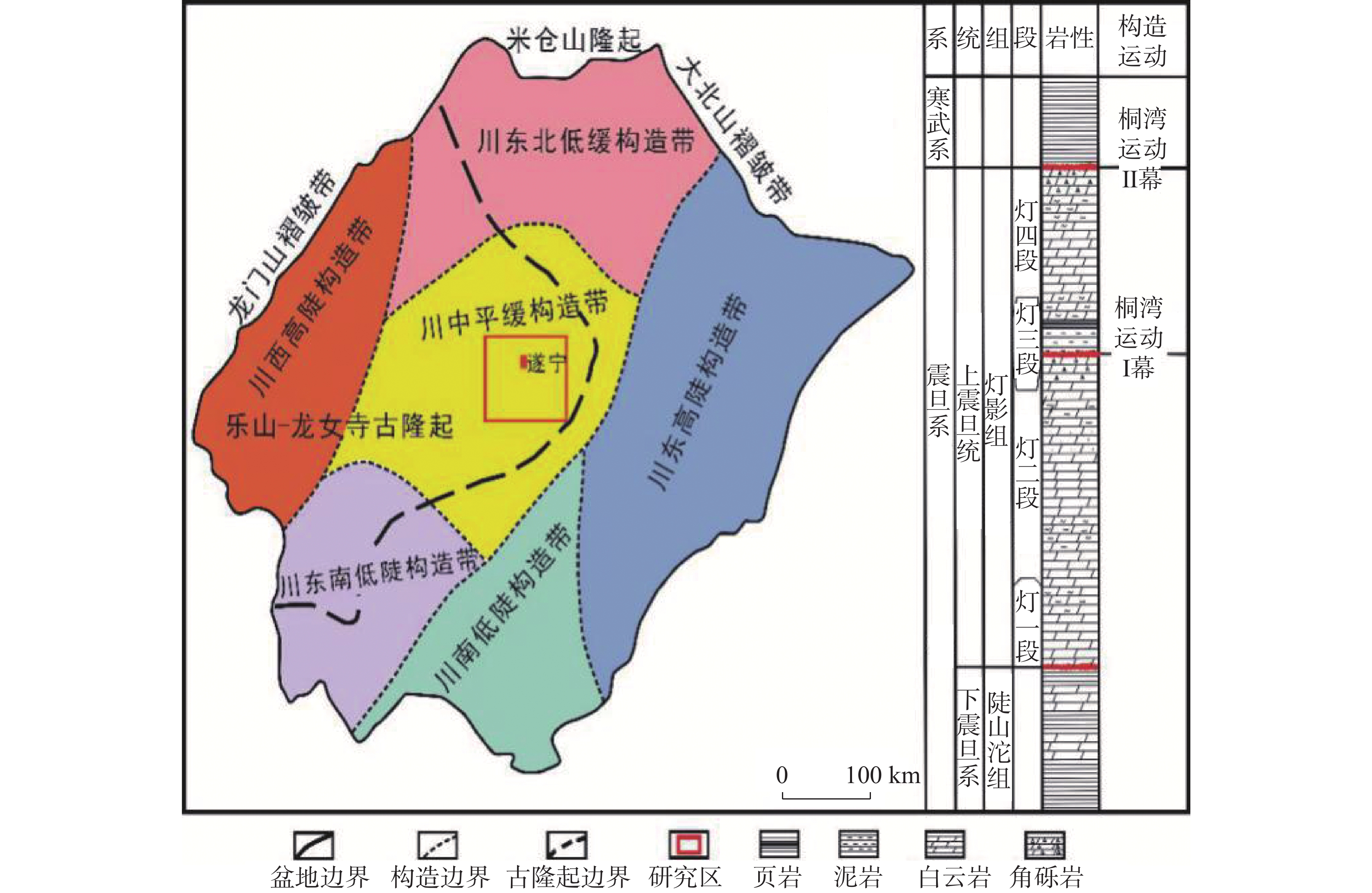Reservoir types and well logging identification of the Sinian Dengying Formation in the Central Sichuan region
-
摘要: 川中地区震旦系灯影组是一套典型的以碳酸盐岩为主的地层,储层结构异常复杂,弄清储层的类型及测井识别,从而进一步指导该区油气的勘探和开发。以岩心、薄片观察、钻井和录井资料为基础,通过对不同类型储层的常规测井和成像测井响应特征进行综合分析。研究区震旦系灯影组的储集空间主要是以次生成岩作用形成的孔隙、孔洞、洞穴和裂缝为主,根据不同储集空间的组合方式,将储层类型划分为孔洞型(顺层状孔洞型、蜂窝状空洞型)储层、裂缝—孔洞型储层、孔隙型储层和洞穴型储层四大类型。不同的储层类型具有不同的测井响应特征,利用研究区内已有的常规测井资料和成像测井资料建立了不同储层类型的测井识别标准,为川中地区灯影组油气的勘探与开发提供了新的思路。Abstract:
The Sinian Dengying Formation, situated in the Central Sichuan region, lies at the eastern high point of the Longnvsi ancient uplift axis in Leshan. This formation possesses both oil source and preservation conditions, making it a promising site for exploration. It is an important target and successor layer for oil and gas exploration in the Sichuan Basin. In 2011, the China National Petroleum Corporation (CNPC) initiated the exploration of oil and gas resources at Well Gaoshi-1 in the Dengying Formation. This endeavor resulted in the successful discovery of oil and gas reservoirs within the Dengying Formation. Therefore, many scholars have conducted a lot of relevant research. However, they have only reached a consensus on the lithology and stratigraphic classification of the strata. There is still great controversy over the results of classifying reservoir types. In the process of oil and gas exploration, understanding the type of reservoir is an important step and a key factor that will directly affect the success of oil and gas exploration and development. The Dengying Formation in the Sichuan Basin has undergone seven major tectonic movements over a geological history of about 600 million years. These movements have led to significant changes in burial depthes and a range of diagenetic processes, resulting in a variety of reservoir space types. As a result, the combination of reservoir spaces is also very complex, leading to significant controversy in the classification of reservoir types. Understanding the type of reservoir is an important link in oil and gas exploration and development, as it directly affects the success of these endeavors. Therefore, this article utilizes rock cores and drilling logs from more than 30 wells in Central Sichuan and its surrounding areas as first-hand data. It conducts in-depth analysis of the reservoir types and logging identification characteristics of the Dengying Formation. In the research process, the existing drilling cores, field profiles, and thin sections of rocks in Central Sichuan and its surrounding areas were used as the main research subjects to study the rock types and storage spaces that constitute the reservoir. The results show that in the Dengying Formation, the lithology is predominantly dolomite, with a small amount of mudstone and siliceous rock. The rock types that form the reservoir are diverse, mainly including grain dolomite, sandstone dolomite, algal laminated dolomite, and karst breccia. The observation of thin sections and rock cores indicates that the current reservoir space is mainly composed of pores, holes, caves, and fractures formed by secondary processes. The pore-type space refers to that with a pore diameter less than 2 mm, mainly including intercrystalline dissolution pores, intergranular pores, and intergranular dissolution pores. The hole-type space refers to that with a pore diameter greater than 2 mm and less than 100 mm, mainly including karst holes along the direction of algal layers, porous karst holes, fractured karst holes, intergranular holes, and residual holes bordered with the shape of grape. The caves-type space refers to that with a pore diameter greater than 100 mm. The fracture-type space refers to a fracture formed by tectonic action, which significantly enhances the storage capacity and permeability of reservoirs in the Dengying Formation. In Central Sichuan, the storage spaces of the Dengying Formation are interconnected and distributed in a combined manner. Based on the primary or dominant reservoir spaces, reservoir types are classified into four categories, pore-holes type, fracture-pore-holes type, pore type, and cave type reservoirs. Each reservoir type exhibits distinct logging response characteristics. With the use of existing conventional logging data and micro-resistivity scanning imaging logging data in the study area, logging identification standards for different reservoir types have been established. This provides new insights for the exploration and development of oil and gas in the Dengying Formation in Central Sichuan. -
Key words:
- Central Sichuan /
- the Dengying Formation /
- reservoir types /
- logging identification /
- imaging logging
-
图 2 川中地区灯影组储集空间类型
a.粒间溶孔,GK1井,5 443.33 m b.晶间孔,Z2井,3706.20 m,×5 (-) c.晶间溶孔,灯四段,先锋剖面 d.藻叠层白云岩,分布有顺藻纹层的溶孔、溶洞,且被白云石和沥青半充填,MX8,5482.76 m,(-),×10 e.顺藻纹层方向的溶(孔)洞, Z6井,5 149.98 m f.孔隙型溶洞, Z4井, 5 486.00 m g砾间洞,洞内被白云石充填,GK1井,5 296.00 m, (+),×1 h.构造裂缝与裂缝型溶洞, GK1井, 5 302.00 m i.残余“葡萄花边”洞,威117井,3 067.6 m
Figure 2. Reservoir space types of the Sinian Dengying Formation in Central Sichuan
a.Intergranular dissolution pores, well GK1 , 5 443.33.00 m,×5(-) b. Intercrystallinepores,well Z2 , 3 706.20 m c.intercrystallinedissolution pores, Z2dn4, Pioneer Geological Profile d.Algal layered dolomite is distributed with dissolved pores and caves along the algal layer, and is semi-filled with dolomite and asphalt, MX8,5 482.76 m, ×5(-) e. Dissolved (pore) holes along the direction of the algal layer, well Z6 ,5 149.98 m f . pore-type karst caves,well Z4 , 5 486.00 m g. inter-gravel caves, filled with dolomite, well GK1,5296.00 m, (+),×1 h.Structural fractures and fracture-type caves, well GK1 , 5 302.00 m i. Residual caves bordered with grape shape, well W117 ,3067.6 m
-
[1] 洪海涛, 包强, 张光荣. 对四川盆地天然气资源的潜在接替层系—震旦、寒武系有利目标区块的评价[J]. 成都理工学院学报, 2000, 27(14):143-146.HONG Haitao, BAO Qiang, ZHANG Guangrong. Evaluation of the favorable target areas for natural gas exploration in the sinian and cambrian systems in sichuan basin[J]. Journal of Chengdu University of Technology, 2000, 27(14): 143-146. [2] 周正, 大华, 张烨, 陈洪凯, 王兴志, 廖云平, 祁永爱, 王宝亮. 中地区震旦系灯影组优质储层的形成条件研究[J]. 中国岩溶, 2023, 42(4):851-862.ZHOU Zheng, LI Dahua, ZHANG Ye, CHENG Hongkai, WANG Xingzhi, LIAO Yunping, Qi Yong ai, Wang Baoliang. Study on formation conditions of high-quality reservoir of Sinian Dengying Formation in central Sichuan[J]. Casologica Sinica, 2023, 42(4): 851-862. [3] ZHOU Zheng, WANG Xingzhi, YIN Ge, YUAN Shuseng , ZEN Shejiao. Characteristics and genesis of the (Sinian) Dengying Formation reservoir in Central Sichuan, China[J], Journal of Natural Gas Science and Engineering, 2016, 29: 311-321. [4] 张声瑜, 唐创墓. 四川盆地灯影组区域地质条件及含气远景[J]. 天然气工业, 1986, 6(1):3-9.ZHANG Shengyu, TANG Chuangmu. RegionaI geology conditions of dengying formation (sinian) in sichuan basin and its gas prospects[J]. Natural Gas Industry, 1986, 6(1): 3-9. [5] 周正, 李大华, 张烨, 陈洪凯, 王兴志, 廖云平, 祁永爱, 王宝亮, 川中地区震旦系灯影组优质储层的形成条件研究[J].中国岩溶, 2023, 42(4): 853-862.ZHOU Zheng, LI Dahua, ZHANG Ye, CHEN Hongkai, WANG Xingzhi, LIAO Yunping, QI Yongai, WANG Baoliang. Study on formation conditions of high-quality reservoir of Sinian Dengying Formation in central Sichuan[J], CARSOLOGICA SINICA, 2023, 42(4): 853-862. [6] 魏国齐, 杨威, 谢武仁, 金惠, 苏楠, 孙爱, 沈珏红, 郝翠果. 四川盆地震旦系—寒武系天然气成藏模式与勘探领域[J]. 石油学报, 2018, 39(12):1317-1327. doi: 10.7623/syxb201812001WEI Guoqi, YANG Wei, XIE Wuren, JING Hui, SU Nan, Sun Ai, Shen Juehong, HaoCuiguo. Accumulation modes and exploration modes and exploration domains of Sinian-Cambrian natural gas in Sichuan Basin[J]. ACTA PETROLEI SINICA, 2018, 39(12): 1317-1327. doi: 10.7623/syxb201812001 [7] 周正. 川中地区震旦系灯影组储层特征[D]. 成都: 西南石油大学, 2016.ZHOU Zheng, Characteristics of the (Sinian) Dengying Formation reservoir in Central Sichuan, China[D]. Chengdu: Southwest Petroleum University, 2016. [8] 天工. 四川盆地乐山—龙女寺古隆起高石梯构造震旦系勘探获重大发现[J]. 天然气工业, 2001, 13(8):51.TIAN Gong. Important discoveries of Sinian system of Leshan-Long nvsi ancient uplift in Sichuan Basin[J]. Natural Gas Industry, 2001, 13(8): 51. [9] 施泽进, 彭俊, 王勇. 川东南地区灯影组储层特征及其控制因素研究[J], 成都理工大学学报(自然科学版), 2010, 37(1): 1-8.SHI Zejing, PENG Jun, WANG Yong. Reservoir features and controlling factors of Dengying Formation in Southeast Sichuan, China[J]. Journal of chengdu university of technology (science & Technology Edition), 2010, 37(1): 1-8. [10] 张林, 魏国齐, 汪泽成, 吴世祥, 沈珏红. 四川盆地高石梯—磨溪构造带震旦系灯影组的成藏模式[J]. 天然气地球科学, 2004, 15(6):584-589. doi: 10.3969/j.issn.1672-1926.2004.06.004ZHANG Lin, WEI Guoqi, WANG Zecheng,WU Shixiang, SHEN Juehong. Analsis of formation mechanism of siniandengying formation in Gaoshiti-Moxi structure belt in sichuanbasin[J]. Natural Gas Geoscience, 2004, 15(6): 584-589. doi: 10.3969/j.issn.1672-1926.2004.06.004 [11] 刘树根, 马永生, 黄文明, 蔡勋育, 张长俊, 王国芝, 徐国盛, 雍自权, 盘昌林. 四川盆地上震旦统灯影组储集层致密化过程研究[J]. 天然气地球学, 2007, 18(4):485-496.LIU Shugen, MA Yongsheng, HUANG Wenming, CAI Xunyu, ZHANG Changjun, WANG Guozhi, XU Guosheng, YONG Ziquan, PAN Changling. Densification process of upper siniandengying formation, Sichuan basin[J]. Natural Gas Geoscience, 2007, 18(4): 485-496. [12] 莫静, 王兴志, 冷胜远, 林刚, 熊剑文, 谢林, 周正, 川中地区震旦系灯影组储层特征及其主控因素[J], 中国地质, 2013, 40(5): 1505-1513.MO Jing, WANG Xingzhi , LENG Shengyuan, LIN Gang, XIONG jianwen, XIELin, ZHOU Zheng. Reservoir characteristics and control Factors of SinianDengying Formation in central Sichuan [J], Geology in China, 2013, 40(5): 1505-1513. [13] 海涛, 姚俊波, 李柏颉, 丁磊, 张世亮, 刘洪光, 塔河油田12区中下奥陶统储层特征及发育控制因素[J], 石油实验地质. 2015, 37(1): 16-19.HAI Tao, YAO Junbo, LI Bojie, DING Lei, ZHANG Shiliang, LIU Hongguang. Characteristics and controlling factors of the Middle and Lower Ordovieian carbonates in the 12th district of the Tahe Oil Field, PETROLEUM GEOLOGY & EXPERIMENT, 2015, 37(1): 16-19. [14] 屈红军, 蒲仁海, 冯杨伟, 塔河油田南部奥陶系储层类型及测井识别特征[J], 西北大学学报( 自然科学版), 2011, 41(1): 90-94.QU Hongjun, PU Renhai, FENG Yangwei, Reservoir types and its log interpretation characteristicsof Ordovician reservoirs in the south area of Tahe Oilfield[J], Journal of Northwest University ( Natural Science Edition), 2011, 41(1): 90-94. [15] 智慧文, 肖慈珣, 李国蓉, 黄科, 汪华. 塔河油田下奥陶统碳酸盐岩储层测井分类识别研究[J].物探化探计算技术, 2006, 28(2): 101-105,83.ZHI Huiwen, XIAO Cixun, LI Guorong, HUANG Ke, WANG Hua. Research on Logging Classification and Identification of Lower Ordovician Carbonate Reservoir in Tahe Oilfield[J], Computing Techniques for Geophysical and Geochemical Exploration. 2006, 28(2): 101-105,83. [16] 智慧文, 杨志彬, 肖兹, 李国蓉, 赵正果. 塔河油田奥陶系碳酸盐岩储层孔隙度测井解释方法研究[J]. 新疆石油天然气, 2007, 3(4): 5-9ZHI Huiwen, YANG Zhibin, XIAO Zi, LI Guorong, ZHAO Zhengguo. Research on porosity logging interpretation method for Ordovician carbonate reservoirs in Tahe Oilfield, xinjiang Oli&Gas, 2007, 3(4): 5-9 -




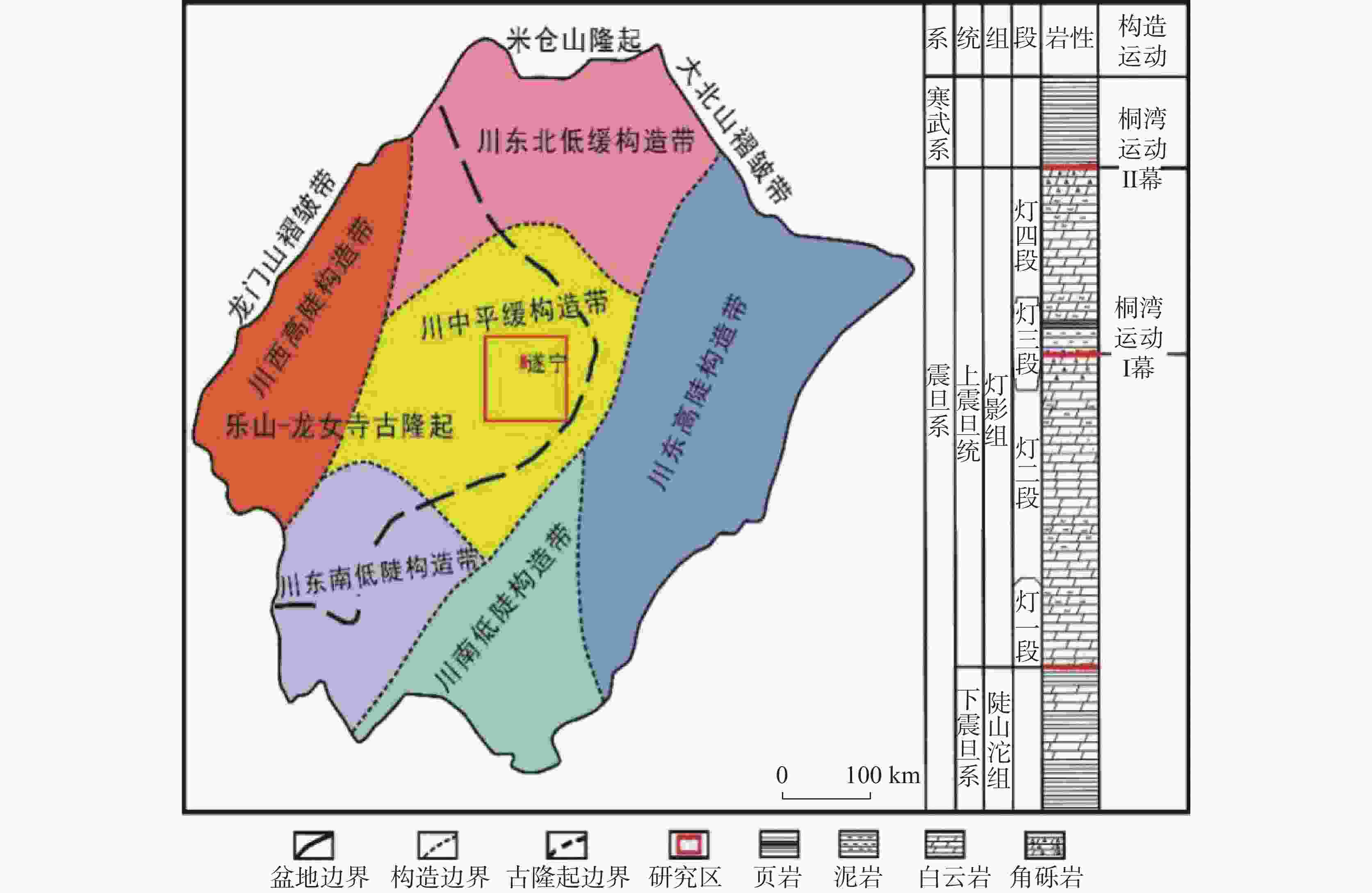
 下载:
下载:
